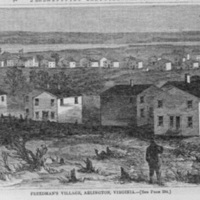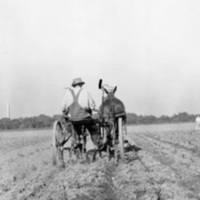Black Communities and the Federal Government
The federal government plays a unique role in Arlington. Large portions of Arlington have been physically occupied and controlled by the federal government throughout the nineteenth and twentieth centuries. Today 18% of the County is federal land.
This federal presence especially impacted Arlington’s black neighborhoods and people.
The War Department established Freedman's Village in 1863 as a "contraband camp" for formerly enslaved African Americans. The Village featured homes, farms, churches, vocational and traditional schools, a hospital, and several fraternal organizations.
In 1900 the federal government formally closed Freedman's Village. African American families and institutions spread throughout the county, expanding existing and creating new communities and transforming the Village's institutions into county-wide institutions, fostering a tight-knit African American community for generations.
The 1910s were a time of expanded federal intervention in Arlington County. This presence especially impacted Arlington’s black neighborhoods and people. On land which had once been Arlington Tract Farms, the farming portion of Freedman’s Village, the Department of Agriculture created an expansive farm for testing new crops and farming techniques. Known as the Experimental Farm, this facility was created in 1913 between the Butler-Holmes and Johnson’s Hill African American communities.
Also in 1913, the Navy erected three huge radio towers in the Johnson’s Hill neighborhood, at the intersection of Columbia Pike and Courthouse Road. These radio towers, called the “three sisters,” were marvels of modern communications technology and engineering in their time. They were the tallest man-made structures in the world upon their completion, towering over local pillar the Washington Monument. This military experiment would have likely been upsetting to local residents because of unknown health risks, the constant humming noise associated with towers of this size, and the blight on their viewscape.
Queen City was one of the African American neighborhoods created as a result of the closing of Freedman's Village. By 1941 the community featured more than 200 working class families, churches, community institutions, and businesses. That year the federal government looked to Arlington County as a location for their expanded War Department building known as the Pentagon. Though not within the grounds of the Pentagon, developers feared that the presence of Queen City so near the federal instillation would mar the new building's environment. Developers condemned Queen City and alloted the land for a new road network.
In February of 1942 residents of Queen City were informed of the decision to raze their community. These individuals and families were given three weeks’ notice and little compensation for their homes. Many residents were forced to relocate to a temporary emergency wartime trailer camp created by the government in nearby Green Valley.




